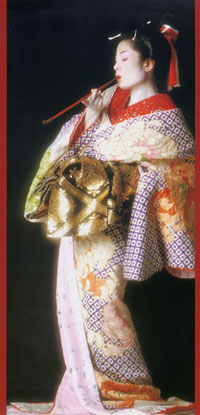| Profile of Yasuko Nagamine | TOP |
|
Yasuko Nagamine was born in Aizu-Wakamatsu City of Fukushima Prefecture.
She started to learn modern dancing at the age of three. In 1960, she left Aoyama-gakuin University and went to Spain to study all by herself. After assiduous training, she performed in the prestigious "Tablao Coral de la Moreria" Flamenco Restaurant, as the first Japanese dancer and received great admiration. In 1975, she performed a dance based on a well-known long poem
"Llanto por Ignacio Sanchez Mejias" by "Federico Garcia
Lorca<Spain's most deeply appreciated and revered poet>" at
the NHK Hall. In 1977, she challenged Salome and succeeded in expressing diabolic
eroticism of a woman to win a Golden Arrow Award. After that, her creative
power knew no limits, turning to other types of music such as rock, Afro
and Samba,crossing national and racial boundaries, avidly absorbing the
blood and rhythm of different cultures-to the creation of her own unique
world. In 1980, she finally came back to Japan. She challenged a famous
Japanese legend Musume Dojoji. In 1982, Musume Dojoji was performed at the Lincoln Center in
New York and impressed the packed audience of over 3,000 greatly, establishing
Nagamine as a full-fledged international dancer "to connect the East
and the West". In 1983, she performed Mandala with the help of 50 Buddhist monks
whose roaring chant beautifully personated the original sin of the human
beings and their final salvation. In 1984, Nagamine brought Mandala to New York and performed in
front of the N.Y audience again and created a great sensation. In 1985, Nagamine danced Sagimusume ( Stork Daughter ), in
1986, Onibaba ( Devil Hag ), in 1987, Adachi-ga-Hara and Ukiyoburo.
They were all based on Japanese legends but treated with original ideas
and concepts and drew much public attention. Since 1988, Yasuko Nagamine has performed Japanese classical works at the National Theater and western works at the Nakano Sun Plaza Theater, every year respectively. |
  |
| Nagamine's N.Y. performances | |
|
1982 Musume Dojoji at the Lincoln Center. 1984 Mandala at the Carnegie Hall. 1993 Sotoba Komachi ( by Yukio Mishima ) at the Equitable Theater, Broadway. |
|
Purple Ribbon Medal for Arts (2001) |
|
| TOP |